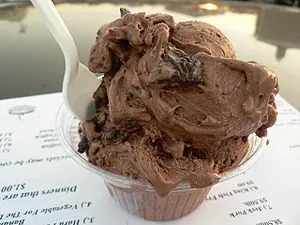Blog
I Scream, You Scream, We All Scream for National Ice Cream Month!

Whether you love chocolate, vanilla, or some fancy flavor full of cookies or candy, there is nothing quite as refreshing during the hot summer days of July as a cone of your favorite ice cream. Odds are, according to the International Dairy Foods Association, the flavor that tops your list is one of the top five which are, in order, vanilla, chocolate, cookies n cream, strawberry, and chocolate chip mint. Americans love their ice cream and almost 10% of the milk our dairy farms produce each year goes into making this frozen treat. We generally prefer eating ice cream we scoop ourselves since 67% of the $10B of ice cream sold in 2010 was the kind you take home and eat later.
What’s What in the Ice Cream Cooler
When it comes to frozen treats, we have a wide variety of options to choose from: ice cream, frozen yogurt, sherbet, etc. Do you know the difference between them? Many consumers don’t and either call something one thing, when it is another or use one term for many different things. To help you understand what is ice cream and what is something else, here is a helpful breakdown, provided by the International Dairy Food Association, explaining what is what when it comes to frozen goodies.
- Ice Cream – This frozen dessert is made from milk and often combined with other ingredients including sweeteners, flavorings, or bite size things like nuts or chunks of chocolate. In order to be considered ice cream, the base product must contain at least 10% milk fat and must weigh 4.5 lbs per gallon.
- Frozen Custard/French Ice Cream – This option is very similar to traditional ice cream but must contain a certain amount of egg yolk solids in addition to the required % of milk fat.
- Gelato – This option, which has a similar consistency to the soft serve version of traditional ice cream, is more dense, less frozen, and is often characterized by the intensity of its flavors. Generally offered in a variety of flavors, gelato also contains egg yolks, like frozen custard, and uses more milk than milk fat in its base.
- Frozen Yogurt – This option uses cultured dairy products to produce a lower-fat alternative that is similar in texture and consistency to traditional ice cream.
- Sherbet (often misnamed Sherbert) – This option, which is generally featured in fruit flavors, is sweeter and much less creamy than traditional ice cream. It contains only 1-2% milk fat and must weigh 6 lbs per gallon.
- Sorbet/Water Ice – This option is Sherbet without the dairy products. Often offered in fruit flavors with a much less creamy texture than ice cream.
- Novelties – This term is used to describe the frozen treats and desserts that do not come in pint, quart, or gallon form. They may or may not contain ice cream, eggs, milk, milk fat, or other traditional ice cream ingredients. This includes ice cream sandwiches, popsicles, fudgesicles, etc.
Cool off, eat something sweet, and support our hard working dairy farmers this July by picking up a gallon or two of your family’s favorites or, even better, try making a flavor or two that is totally new. A good one to start with is Avocado and Pistachio from Fill Your Plate.
Related Articles:
- Planning the Perfect 4th of July Party (fillyourplate.org)
- Get Down With Dairy this Month (fillyourplate.org)
- Celebrate Dairy Month with Gourmet Milkshakes Made By Celebrity Chefs (fillyourplate.org)
















